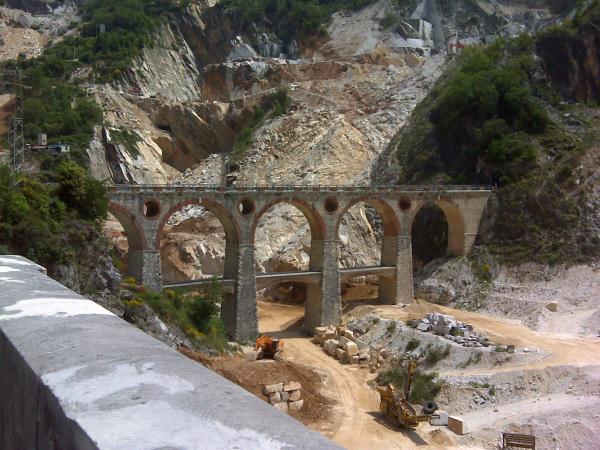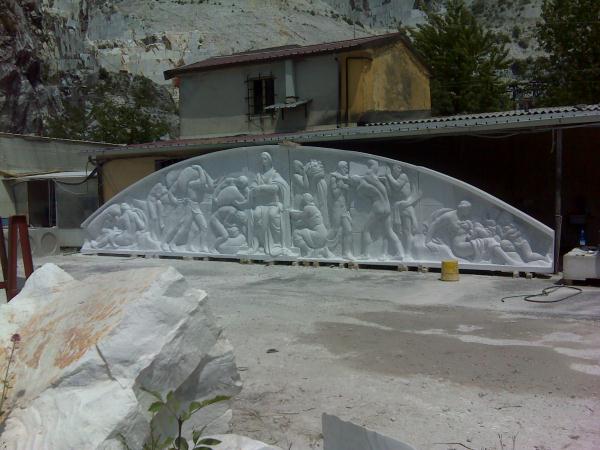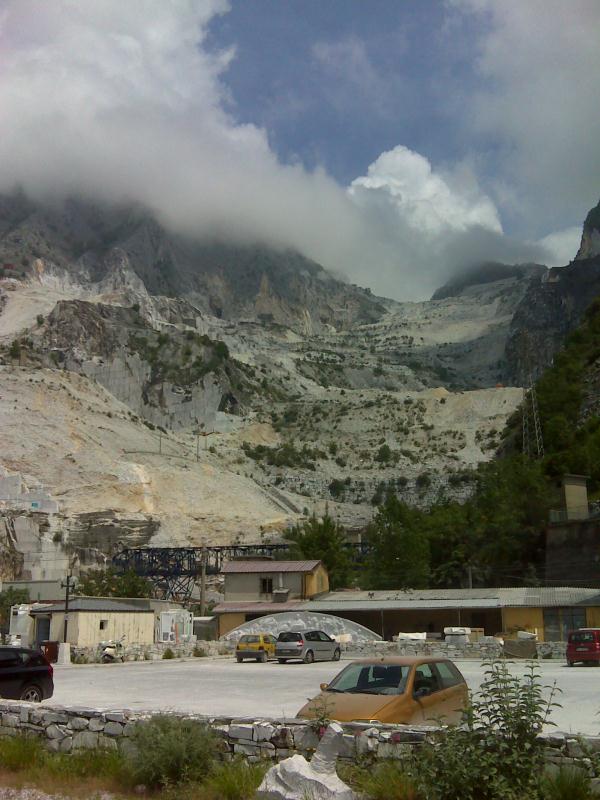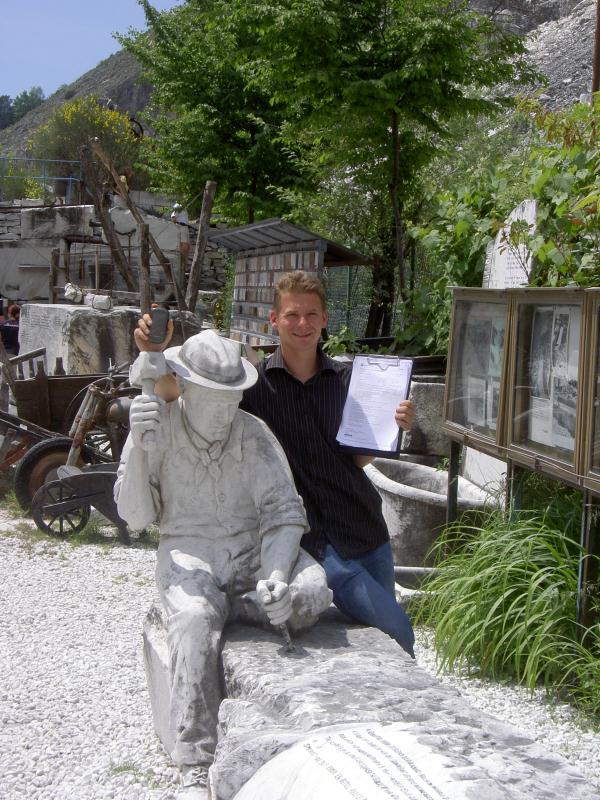This Earthcache takes you to the famous white gold of Carrara:
The Carrara Marble
How marble is formed:
The process of how marble is created is always
pretty much the same, no matter what colour it is. Marble is a
metamorphic rock, which means it is created by the transformation
of other rocks like calcite, dolomite or aragonite. The process of
transformation takes high temperatures as well as high pressures
under the earth’s surface in order to change the crystalline
structure of the rocks – during a process of complete
re-crystallization, marble is formed. The resulting colour is
caused by the minerals that have been transformed, for example, red
marble indicates the presence of hematite, yellow marble is caused
by limonite. Carrara marble is typically white as a result of the
metamorphosis of almost pure calcite. Its creation started over 200
million years ago in the Triassic period with the process of
sedimentation, when dead organisms and organic materials settled
down on the earth’s surface, forming a huge layer of
sediments. The transformation was caused by the movement of the
tectonic plates, when the African plate started pushing against the
Eurasian plate. The pressure and temperatures within the earth
initiated a process of change of the sedimentary rock into marble,
creating mountains of up to 1900 meters high which consist mainly
of marble.
The quarries in Carrara:
Finds show that the first quarries at Carrara go
back to the 2nd century BC. The Romans were the first to quarry
huge amounts of marble, using it for palaces and sculptures. Since
then, marble has been quarried continuously for more than 2000
years. The demand has varied over the centuries. During the Roman
era, the demand was rather high, whereas during baroque, white
marble was rather unpopular. During the two world wars and the
global economic crisis, mining came to an almost complete stop. It
was in the 1960s that mining at Carrara started to boom again, and
the number of quarries has increased significantly since then. The
road system has been expanded as well. Today, there are around 100
quarries in the valleys of Frantiscritti, Torano and Collonata.
The Marble Mine – Galleria Ravaccione (Header
Coordinates):
In order to transport the big marble blocks
downhill, a railroad was constructed. The railroad line was opened
in 1876, leading across several bridges and through several
tunnels. However, it was rather slow, and with the construction of
more and better roads, trucks became more important. Soon, the
railroad had become obsolete and the line was closed. But workers
had already noticed during the construction of the tunnels that the
quality of the marble inside the mountain was excellent. A man
called Carlo dell’ Amico had the idea to cut the marble
blocks from within the tunnels, and started to run a marble mine:
the Galleria Ravaccione. As marble is normally cut in quarries
above the earth’s surface, these mines are something very
special and unique in the world! The mine is still active nowadays,
but guided tours are offered, which are very interesting. I
recommend you to take part in one of the tours, if you have the
opportunity. It surely is a sensational experience! However, to
claim the cache as found, it is not necessary to go on the tour.
More information can be found on Marmotour.com
The Cache:
To get to the header coordinates, follow the
yellow signs “cave di marmo” leading from the town up
the hill. In the area around the header coordinates, you will find
a parking lot, as well as a marble museum and a small shop. The
entry to the museum is free, and it is worth seeing! Just a few
meters away, you will find a little hut, where the tours to the
mine start.
To claim this Earthcache as found you need to
complete the following tasks:
- at the header coordinates, you will find a sign, giving
information about the quarries during the Roman era and the
Frantiscritti Area. When exactly was the Luni Colony founded?
- Take a picture showing you and your GPSr with the “marble
man” near N44° 05.424 E010° 08.021 (see sample picture). The
entry to this museum is free.
- Next to the marble man, you will find a bull figure made of
marble. Estimate the weight of the marble sculpture!
Email me your answers and add the picture to
your log. You don’t need to wait for my reply, just go ahead
and log your find – if there’s anything wrong, I will
contact you. Logs without a picture will be deleted without further
comment.
The old Marble Railroad / Die alte
Marmorbahn

Marble Sculpture / Marmorskulptur

Marble Quarry / Marmorsteinbruch

Dieser Earthcache führt euch zum weltberühmten weißen Gold von
Carrara: dem Carrara-Marmor.
Die Entstehung des Marmors:
Die Entstehung von Marmor ist im Prinzip immer
ein sehr ähnlicher Prozess, egal, welche Farbe er hat. Marmor ist
ein metamorphes Gestein, das bedeutet, es entsteht durch Umwandlung
von anderem Gestein, wie z.B. Calcit, Dolomit oder Aragonit. Bei
entsprechendem Druck und den richtigen Temperaturen im Erdinneren
verändert sich die kristalline Struktur des abgelagerten Gesteins,
und es entsteht Marmor. Die Farbe des Marmors wird dabei durch die
eingelagerten Stoffe bestimmt: Hämatit gibt dem Marmor z.B. eine
rötliche Färbung, Limonit verleiht ihm eine gelbliche Färbung.
Carrara-Marmor erhielt seine typische Färbung, weil er fast
ausschließlich aus Calcit besteht. Im Trias, vor fast 200 Millionen
Jahren, lagerten sich abgestorbene Organismen und andere
biologische Ablagerungen am Meeresboden ab, und bildeten eine dicke
Sedimentschicht. Die Umwandlung begann, als sich die Afrikanische
Platte und die Europäische Platte aufeinander zubewegten. Dadurch
entstanden im Erdinneren der notwendige Druck und die Temperatur,
um die kristalline Struktur und die Form der Ablagerungen zu
verändern: es entstand ein bis zu 1900 Meter hohes
Marmorgebirge.
Der Abbau des Marmors in Carrara:
Bereits seit dem 2. Jahrhundert vor Christus
wird in Carrara Marmor abgebaut. Schon die Römer benutzten die
Marmorblöcke für Prunkbauten und Kunstwerke. Seit dieser Zeit, also
seit mehr als 2000 Jahren wird in Carrara fast kontinuierlich
Marmor abgebaut, allerdings mit wechselnder Nachfrage. So war die
Nachfrage zur Zeit der Römer sehr hoch, im Barock hingegen war die
Nachfrage nach weißem Marmor eher gering. Der erste und zweite
Weltkrieg, sowie die Weltwirtschaftskrise brachten den Abbau fast
zum Erliegen. Erst in den 1960er-Jahren erlebten die Steinbrüche
wieder einen Aufschwung, und auch das Straßensystem wurde
ausgebaut. Heute gibt es insgesamt etwa 100 Steinbrüche in den
Becken von Fantiscritti, Torano und Collonata.
Die Marmor-Höhle – Galleria Ravaccione
(Headerkoordinaten):
Zum Abtransport des Marmors wurde eine Eisenbahn
errichtet, die die Blöcke ins Tal transportieren sollte – sie
wurde 1876 in Betrieb genommen, und führte über zahlreiche Brücken
und durch einige Tunnel. Allerdings fuhr diese Eisenbahn sehr
langsam, und wurde mit dem Ausbau der Straßen und mit der
Verlagerung des Transports auf Trucks eingestellt. Allerdings wurde
schon damals, beim Bau der Tunnels, festgestellt, dass die Qualität
des Marmors im Inneren der Tunnels besonders hoch war. So war es
Carlo dell’Amico, der die Idee hatte, den Tunnel auszuhöhlen,
und den Marmor unter Tage abzubauen. Es entstand die
„Galleria Ravaccione“. Da Marmor normalerweise nur in
oberirdischen Steinbrüchen abgebaut wird, sind diese Marmorhöhlen
eine Besonderheit und weltweit einzigartig! Die Mine ist immer noch
aktiv, jedoch werden Führungen angeboten, die ich jedem nur
empfehlen kann – ein einzigartiges Erlebnis! Zum Loggen
dieses Caches ist eine Tour allerdings nicht notwendig. Nähere
Informationen sowie die aktuellen Eintrittspreise findet man unter
Marmotour.com
Um zu den Headerkoordinaten zu kommen, folge vom
Ort Carrara kommend einfach den gelben Hinweisschildern „cave
di marmo“. Rund um die Koordinaten wirst du einen Parkplatz
finden, und nur wenig entfernt befindet sich ein kleiner
Souvenirshop, sowie ein kleines Marmor-Museum. Der Eintritt in das
Muesum ist kostenlos und ein Besuch ist auf alle Fälle
empfehlenswert. Nur wenige Meter enfernt befindet sich eine kleine
Hütte, bei der die geführten Touren in die Marmorhöhle
beginnen.
Der Cache:
Um diesen Earthcache zu loggen, sind folgende
Bedingungen zu erfüllen:
- an den Headerkoordinaten findest du ein Schild, welches
Informationen über die Steinbrüche zur Zeit der Römer und das
Fantiscritti-Areal gibt. Wann wurde die Luna-Kolonie (Luni Colony),
ein Umschlagplatz für den Marmor, genau gegründet?
- Mache ein Foto von dir und deinem GPSr mit dem Arbeiter bei
N44° 05.424 E010° 08.021 (siehe Beispielfoto). Der Eintritt in das
Museum ist kostenlos.
- Neben der Arbeiterfigur steht die Figur eines Stiers, die
komplett aus Marmor besteht. Schätze das Gewicht der
Marmorskulptur!
Sende mir die Antworten per E-Mail und füge
deinem Log das Foto an. Du brauchst meine Antwort nicht abzuwarten,
du kannst deinen Fund gleich loggen – sollte etwas nicht in
Ordnung sein, melde ich mich bei dir! Logs ohne Fotos werden ohne
Kommentar gelöscht.
Happy Caching! - Qualiflyer
